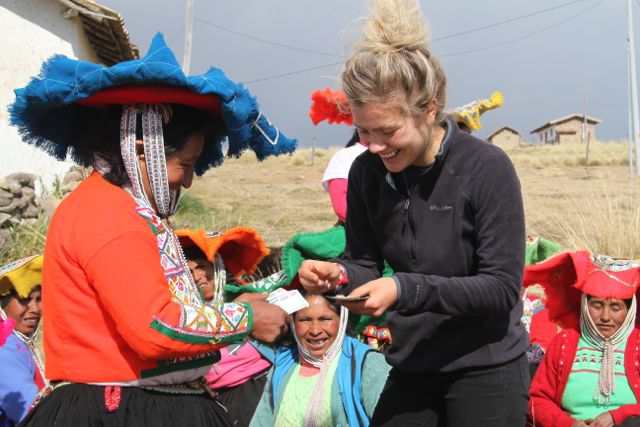In our three-part blog series, we look at the Three Pillars of Sustainability: environmental, economic and social and how they can be incorporated into “sustainable fashion”. Below is Part II: Economic Aspects of Sustainability.
The Artisan Sector Provides Economic Opportunities to Rural Communities
“With appropriate support, the artisan sector provides an opportunity to transform the international economic landscape.” – The Artisan Alliance (formerly the Alliance for Artisan Enterprise)
The artisan sector represents a market of $34 billion globally.[1] It is the second largest employer in the developing world and has the potential to not only strengthen unique cultural traditions but also “create jobs, increase incomes, and foster sustainable community development.”[2]
In remote Andean communities, there are few work opportunities other than agriculture, and weaving has proven to be a good source of supplementary income.

Rejina and Eulalia set up their looms outside against the dramatic backdrop of an oncoming rain shower in Upis. Photo by: Sarah Confer
As mentioned in Part I: Environmental Aspects of Sustainability, most families raise alpaca and sheep. Many families sell the fleece to middlemen who then sell to distributors and ultimately to large-scale yarn manufacturers. This is a valuable source of income for them, but if they are instead able to use some of this fibre to produce finished goods, they can earn over 50 times as much for the same amount of raw alpaca fibre.

Alejandrina prepares freshly shorn alpaca fleece to sell to an acopiador, an alpaca fiber middleman. Photos by: Lizz Giordano.
 The Miski scarf - shown here in Rose, Lake, Cream and Brick - are woven using extra-soft alpaca fiber from the weavers' own herds of alpaca in Upis. Photo by: Mariah Krey.
The Miski scarf - shown here in Rose, Lake, Cream and Brick - are woven using extra-soft alpaca fiber from the weavers' own herds of alpaca in Upis. Photo by: Mariah Krey.
Many of our pillows, rugs, scarves and ponchos use yarn spun from the weavers’ own herds of sheep and alpaca!
Market Access: One of the biggest problems facing producers
However, most artisans have few opportunities to bring their work to market. For most of the weaving associations we work with, Threads of Peru represents one of very few opportunities they have to sell their textiles; for a few, we are their only outlet. Some artisans have the opportunity to sell to trekkers who pass through their community, or at municipal fairs. But this represents only a handful of selling opportunities per year, during each of which they might sell only a few items, or perhaps none.

Weavers in Upis put the finishing touches on a Pika alpaca blanket, made for Threads of Peru customers. Photo by: Mariah Krey.
This is where Threads of Peru comes in.
We operate an online shop where we sell the artisans’ woven goods directly to international consumers, and we also work with about 25-30 wholesale clients located primarily in the US and Europe. As we grow, so do the benefits for the weavers. After analyzing our purchases in one of our seven partner communities, we saw that in the first half of 2018, there was a nearly 350% increase in the number of orders compared to the same period in 2017.

Our website features tonnes of handwoven textile items, from bags like this Tupu wool and leather backpack, to home textiles and other fashion accessories. Photo by: Anna Watts.
Currently, over 120 families are supported through weaving for Threads of Peru, and income from weaving represents a 25-50% increase in the weavers’ annual income.
Although we, too, depend on demand and the orders we receive, we can still guarantee at least three buying periods per year where we might buy anywhere from 10 to 200 items in each community. And we always pay the weavers up front for their work.
More Than Just Direct Investment: The ripple effect of empowering women

Isabel proudly shows off one of her textiles during a recent visit to Chaullacocha, and explains what all the woven symbols mean. Photo by: Eric Mindling.
In addition to financial support, the skills these Peruvian artisans develop as a result of working with Threads of Peru leaves them equipped to find and take on new opportunities of their own. We’ve seen this in action as weavers tell us about weaving awards they’ve won, and about travelling to Lima or Arequipa for fairs, workshops or other events that they have been invited to or which they have sought out themselves.
Keep reading:

